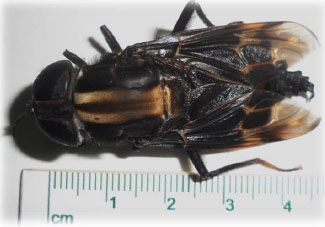All published articles of this journal are available on ScienceDirect.
New Record of the Giant Timber Flies (Diptera: Pantophathalmidae) from Sartenejas Valley, Miranda, Venezuela
Abstract
Giant timber flies Pantophthalmus bellardii (Austen 1923) have been collected at 1200 meters above sea level, at Sartenejas Valley, a campus of the Universidad Simón Bolívar, Miranda State, Venezuela. Giant timber flies are very difficult to find in nature and rarer yet in the urban environments. Their biology and interactions with environmental variables are virtually unknown. In Venezuela, these flies have been observed from 100 to 1100 meters above sea level. This record extends the geographical distribution of this rare timber fly within Venezuelan territory. An updated distribution map for P. bellardii in Venezuela is provided.
1. INTRODUCTION
Pantophathalmidae or giant timber flies are among the l-argest Diptera, with wingspan up to 10 cm [1-3]. Giant timber flies (Diptera: Pantophathalmidae) are very rare [1] and are endemic in Neotropical region [2]. Actually, only 20 valid species are recognized in two genera: Opetiops (Enderlei, 1921) and Pantophthalmus (Thunberg 1919) [2,3]. Traditionally, large size has been the most notable characteristic trait of the Pantophathalmidae.
Giant timber flies are living on dead or still alive trees [2] on which their larvae feed on accumulated organic matter or on the wood fermentation products. The adults emerge for the reproduction only and are aphagus (do not feed past larval stage).
Their regional geographical distribution has been covered by Val [4] and recently Amat [5] has added important data about Panthopthalmidae distribution in Mexico and their biology in the Red Oak forest (for Pantophthalmus roseni (Enderlein 1931) within Mexico. Pujol-Luz and Souto Morgado [2] offer new data about Pantophthalmus pictus (Wiedeann 1821) records from central Brazil. Despite the recent progress on giant timber flies studies, very little information is available regarding their distribution in Venezuela.
Here we are reporting a rare case of the Pantophthalmidae urban record in Venezuela. Such record was made for the first time for Pantophthalmus bellardii for Sartenejas Valley (Miranda, Venezuela) at 1.200 meters above sea level [3], at the campus of Universidad Simón Bolívar (Fig. 1).
1.1. Collected Material
The University is inside a valley surrounded by evergreen primary forest. The main campus is encircled by the plantations of Pinus caribea, P. pseudostrobus and P.patula [6]. Nowadays, it is a very stable conifer forest that keeps the climate constant and protects the original forest.
Two specimens of Pantophthalmus bellardii (Austen 1923) [3], a male and a female, (Fig. 2) were found dead on the roof of the Química y Procesos building (QYP) at the central area of the campus.
The genus identification was done by Dr. Torsten Dikow, (Research Entomologist for Diptera of Smithsonian Institution Natural Museum of Natural History) and Val [4] was used for the final identification of the species.
The female was 4.5 cm long (from tip of head to tip ovipositor) (Fig. 3), curve ovipositor; 3.6 cm length (Fig. 4). Abdomen coloration varies from black (female) to pale orange (male). Both specimens have beige parallel lines at the mesonotum. As it was noted by Val [4], the female is larger than the male.
The presence of P. bellardii at Sartenejas Valley (Miranda Venezuela) at 1200 meters above sea level, is an important extension of the altitudinal profile of the Panthopthalmidae records in Venezuela. It is also the first record of this family for the Miranda State.





1.2. Summary of the Pantophthalmus bellardii records in Venezuela
Panthopthalmidae are currently reported from only a handful of sites in Venezuela. Báez [1] recorded P. bellardii in Choroní (100 meters above sea level, Aragua State), El Limón (450 meters above sea level), Ocumare de La Costa (400 meters above sea level, Aragua), Rancho Grande (1100 meters above sea level, Aragua, Henri Pittier National Park) and Sierra de Perijá (800 meters above sea level, Zulia). Fig. (5) shows the current updated location and distribution of this species along the country.
The current distribution records of the Pantophthalmus bellardii [2], [3] extend the current knowledge of the species distribution alongside the records from Colombia [5], Brazil [3] and Venezuela of the timber giant fly [1]. It is also the highest altitude above sea level at which the species have been encountered so far in Venezuela. This new record is important for the studies of the Giant Timber flies, which probably act as an important ecosystem engineers and forestry pests, facilitating organic matter flow in the Neotropical forests.
CONSENT FOR PUBLICATION
Not applicable.
FUNDING
None.
CONFLICT OF INTEREST
The authors declare no conflict of interest, financial or otherwise.
ACKNOWLEDGEMENTS
We thank the identification to genus level to Dr. Torsten Dikow, (Research Entomologist for Diptera of Smithsonian Institution Natural Museum of Natural History) which kindly help us with this material. Also, to Dr. Solange Issa for her comments and suggestions for the present note. To Dr. M. Báez (Departamento de Biología Animal, Edafología y Geología, Universidad de La Laguna, España) y Dr. José Clavijo (Facultad de Agronomía Universidad Central de Venezuela) for their help in the search for bibliography associated with the giant timber flies in Venezuela and Dr. Viktor Banarov for suggestions regarding the manuscript.


